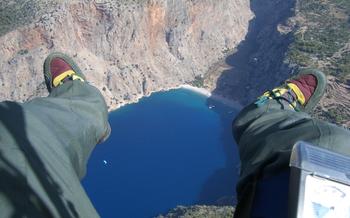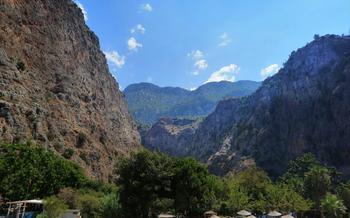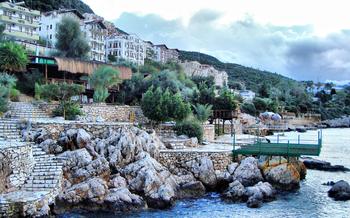
Lycian Rock Cemetery
- Historical Significance
- Location
- Accessibility
- Things to See
- Tour Options
- Self-Guided Exploration
- Photography Opportunities
- Historical Context
- Combining with Other Attractions
- Respecting the Site
- Practical Tips
- Additional Historical Sites
- Cultural Significance
- Local Crafts and Souvenirs
- Insider Tip:
Historical Significance
The Lycian Rock Cemetery is a testament to the ingenuity and artistry of the ancient Lycian civilization. Originating in the 4th century BC, these tombs were carved directly into the sheer cliffs of the Taurus Mountains. Constructed as the final resting places of prominent individuals, the Lycians believed in an afterlife where the soul continued to exist. The unique architecture and design of the tombs reflect Lycian cultural and artistic traditions, showcasing their sophisticated craftsmanship and deep connection to their surroundings. The impressive scale and intricate details of these rock-cut tombs continue to captivate visitors, providing a glimpse into the lives and beliefs of the ancient Lycians.
Location
The Lycian Rock Cemetery is nestled amidst the picturesque landscapes of Ölüdeniz. To reach this ancient site, take a leisurely stroll along the scenic promenade that leads from Ölüdeniz Beach. As you make your way towards the south, the breathtaking views of the turquoise waters and the mountainous backdrop will captivate your senses. The cemetery is situated just a short distance from the beach, making it easily accessible for visitors who wish to immerse themselves in history and culture.
Once you arrive at the site, you'll find yourself surrounded by the remnants of a once-thriving civilization. The proximity of the cemetery to the beach and other popular attractions in the area, such as the Blue Lagoon andbutterfly Valley, allows visitors to combine their visit with other unforgettable experiences. Moreover, the site is well-equipped with amenities such as parking facilities, restaurants, and restrooms, ensuring a comfortable and hassle-free visit for all.
Accessibility
The Lycian Rock Cemetery is generally accessible, but visitors should be aware of certain challenges. The site is situated on a hill, and the path leading to the tombs involves some uphill walking. Sturdy footwear is recommended, as the terrain can be uneven and rocky. The paths are generally well-maintained, but visitors with mobility issues may require assistance. The site does not have designated wheelchair access, so visitors with disabilities should plan accordingly. It is advisable to bring water and wear sunscreen, as there is limited shade in the area. Visitors are encouraged to respect the historical significance of the site and avoid touching or disturbing any artifacts or structures.
Things to See
Within the Lycian Rock Cemetery, visitors can explore a diverse range of tombs that showcase the architectural prowess and artistic sensibilities of the ancient Lycians. The most striking feature of these tombs is their unique design, which involves carving elaborate facades directly into the natural rock formations. The tombs vary in size and complexity, from simple niches to grand structures resembling small temples.
One of the most notable tombs is the "Painted Tomb," which features vibrant frescoes depicting scenes from Greek mythology and daily life. These colorful murals offer a glimpse into the beliefs and artistic traditions of the Lycians, providing valuable insights into their cultural heritage.
Other tombs are adorned with intricate carvings and inscriptions, which provide information about the deceased individuals buried within. These inscriptions often include the names, titles, and accomplishments of the deceased, offering a glimpse into the social and political structure of ancient Lycia.
Another fascinating aspect of the cemetery is the presence of sarcophagi, which were used to hold the remains of the deceased. These stone coffins are often elaborately decorated with reliefs depicting mythological figures, animals, and floral motifs, adding to the artistic and cultural significance of the site.
Tour Options
Exploring the Lycian Rock Cemetery with a knowledgeable guide is highly recommended. Guided tours offer a deeper understanding of the site's history, significance, and cultural context. Experienced guides can provide insights into the architectural features, symbolism, and funerary practices of the ancient Lycians. They can also point out hidden details and share stories that bring the site to life.
Guided tours are typically offered by local tour operators and can be booked in advance or on arrival in Ölüdeniz. Prices vary depending on the duration and inclusions of the tour. Some tours may include transportation from your hotel, while others may require you to meet at a designated location. It's advisable to inquire about tour schedules and availability to ensure a spot.
Joining a guided tour has several benefits. First, it allows you to learn more about the Lycian civilization and the significance of the rock-cut tombs. Second, you can ask questions and get personalized explanations from the guide. Third, guided tours often take you to specific tombs that are not easily accessible on your own.
Whether you choose to explore the Lycian Rock Cemetery independently or with a guide, it's important to respect the site's cultural significance and avoid disturbing any structures or artifacts. Remember that these tombs are a testament to the rich history and heritage of the ancient Lycians, and it's our responsibility to preserve them for future generations.
Self-Guided Exploration
For those who prefer a more independent experience, exploring the Lycian Rock Cemetery on your own is an equally rewarding option. Start by following the main path that leads to the cemetery, taking your time to admire the surrounding natural beauty. As you enter the site, you'll encounter a series of tombs, each with its unique architectural features and historical significance.
To ensure you don't miss any of the significant tombs, consider following a suggested route that takes you past the most notable ones. Look out for the Tomb of the Nereids, with its intricate carvings and well-preserved facade. The Tomb of the Columns, with its impressive row of Doric columns, is another must-see. And don't miss the Harpy Tomb, named after the mythical creatures depicted on its frieze.
Remember, the Lycian Rock Cemetery is a cultural heritage site, and it's important to respect its significance. Avoid touching or disturbing any artifacts or structures, and be mindful of your behavior to preserve the site for future generations. Embrace the opportunity to connect with the past as you wander among these ancient tombs, each telling a unique story about the Lycian civilization.
Photography Opportunities
The Lycian Rock Cemetery is a treasure trove of photographic opportunities. The towering tombs, with their intricate carvings and weathered facades, provide a stunning backdrop for capturing the essence of ancient Lycia. The play of light and shadow on the rock-cut structures creates an ever-changing canvas that invites photographers to experiment with different angles and compositions.
The best time to visit the cemetery for photography is early morning or late afternoon, when the warm, golden light illuminates the tombs and casts long, dramatic shadows. Photographers can capture the grandeur of the site by shooting wide-angle shots that encompass the entire necropolis or focus on the details of individual tombs, showcasing their unique architectural features and inscriptions.
For those seeking a more creative perspective, the cemetery offers hidden corners and vantage points that reveal unexpected compositions. A climb to the higher levels of the cemetery provides panoramic views of the surrounding landscape, including the turquoise waters of the Mediterranean Sea and the lush green slopes of the Taurus Mountains.
Whether capturing the timeless beauty of the tombs or the interplay of light and shadow, the Lycian Rock Cemetery is a photographer's paradise, offering endless possibilities for capturing the essence of this ancient civilization.
Historical Context
The Lycian civilization flourished in ancient Anatolia, leaving behind a rich legacy of cultural and historical significance. Originating in the 5th century BC, the Lycians established a powerful maritime empire that spanned the southern coast of Turkey. Known for their seafaring prowess and trading skills, they developed a unique blend of Anatolian, Greek, and Persian influences that shaped their culture and artistic traditions.
The Lycians were renowned for their elaborate burial practices, which reflected their beliefs about the afterlife. They constructed impressive rock-cut tombs, such as those found in the Lycian Rock Cemetery, to honor and commemorate their deceased loved ones. These tombs served as a testament to the Lycians' architectural expertise and artistic flair, showcasing intricate carvings, decorative facades, and inscriptions that provided insights into their lives and customs.
Preserving and protecting the Lycian Rock Cemetery is of paramount importance, as it represents a valuable chapter in the history of ancient Anatolia. By safeguarding this unique site, we ensure that future generations can continue to marvel at the artistry and cultural legacy of the Lycian civilization.
Combining with Other Attractions
Ölüdeniz is a treasure trove of natural and historical wonders, inviting you to explore beyond the Lycian Rock Cemetery. Combine your visit with a refreshing dip in the turquoise waters of Ölüdeniz Beach, famous for its stunning Blue Lagoon and paragliding opportunities. Take a scenic boat trip to Butterfly Valley, a secluded paradise teeming with exotic butterflies and mesmerizing rock formations. For a taste of ancient history, venture to the ruins of Xanthos, a once-thrilling Lycian city, or marvel at the intricate rock-cut tombs of Tlos. Don't miss the Saklıkent Gorge, a natural wonder with towering canyon walls and refreshing waterfalls, ideal for a refreshing hike. Create an itinerary that allows you to immerse yourself in the rich tapestry of Ölüdeniz, blending history, nature, and adventure.
Respecting the Site
The Lycian Rock Cemetery holds immense cultural and historical significance, and it is crucial for visitors to respect its sanctity. Visitors should refrain from touching or disturbing any artifacts, structures, or inscriptions found within the cemetery. It is important to remember that these tombs are the resting places of ancient individuals, and any actions that could damage or disrespect their final resting places should be avoided. Responsible behavior and conservation efforts are essential to preserving the Lycian Rock Cemetery for future generations to appreciate and learn from. Visitors should also be mindful of noise levels, as excessive noise can disturb the peaceful atmosphere of the site. By respecting the cultural heritage and significance of the Lycian Rock Cemetery, visitors can contribute to its preservation and ensure that its stories and mysteries continue to captivate generations to come.
Practical Tips
For a comfortable and enjoyable visit to the Lycian Rock Cemetery, consider these practical tips:
-
Attire: Opt for comfortable clothing and sturdy shoes suitable for walking on uneven surfaces.
-
Supplies: Bring water, sunscreen, and a hat to protect yourself from the sun.
-
Precautions: Be mindful of your surroundings and avoid touching or climbing on the tombs.
-
Guided Tours: Guided tours are available for those interested in learning more about the history and significance of the site.
-
Ticket Prices: Admission to the cemetery is typically included in the entrance fee for Ölüdeniz.
-
Opening Hours: The cemetery is usually open to the public during daylight hours.
-
Local Customs: Respect local customs and traditions by dressing modestly and behaving respectfully.
Additional Historical Sites
Beyond the Lycian Rock Cemetery, Ölüdeniz offers a wealth of additional historical sites that provide a glimpse into the region's rich past. Telmessos, an ancient city located just a short distance from Ölüdeniz, boasts impressive ruins that include a well-preserved amphitheater, city walls, and intricate rock-cut tombs. Letoon, a UNESCO World Heritage Site, is another must-visit destination, showcasing the remains of an ancient religious center dedicated to the Lycian gods Apollo, Leto, and Artemis. The site features impressive temples, altars, and a theater, all set against a stunning backdrop of mountains and forests.
For those seeking a deeper understanding of Lycian history and culture, the Fethiye Museum offers a fascinating collection of artifacts, including Lycian sculptures, jewelry, and pottery. The museum provides insights into the daily lives, artistic achievements, and religious practices of the ancient Lycians. These additional historical sites, each with its own unique story to tell, complement the experience of visiting the Lycian Rock Cemetery, offering a comprehensive exploration of the region's rich cultural heritage.
Cultural Significance
The Lycian Rock Cemetery holds immense cultural significance as it offers a glimpse into ancient Lycian burial practices and beliefs about the afterlife. The tombs were designed to reflect the social status and achievements of the deceased, often featuring elaborate decorations and inscriptions that tell stories of their lives and accomplishments. The unique artistic expressions and symbolism found in the tombs provide valuable insights into Lycian culture and their worldview. These burial chambers serve as a testament to the cultural and religious significance of death and the afterlife in ancient Lycian society, shedding light on their beliefs about the journey to the next realm.
Local Crafts and Souvenirs
To cherish your visit to the Lycian Rock Cemetery, consider purchasing unique souvenirs from local shops or markets. These treasures will not only remind you of the rich Lycian history but also support local artisans and preserve traditional crafts. Look for handcrafted items made with intricate designs and motifs inspired by Lycian art. Traditional textiles, such as colorful kilims and rugs, are also popular souvenirs. For a truly special memento, consider purchasing replicas of Lycian artifacts, such as ceramic vessels, jewelry, or miniature sculptures. By supporting local artisans and preserving these traditional crafts, you contribute to the continuation of Lycian cultural heritage.
Insider Tip:
For a truly unique experience, visit the Lycian Rock Cemetery during the annual "Lycian Nights" event, held every summer. This special event brings the ancient tombs to life with live performances, historical reenactments, and traditional music and dance. As the sun sets and the stars emerge, the cemetery transforms into a magical setting, offering a glimpse into the past and the vibrant culture of ancient Lycia. Don't miss this opportunity to immerse yourself in the history and beauty of this remarkable site.









